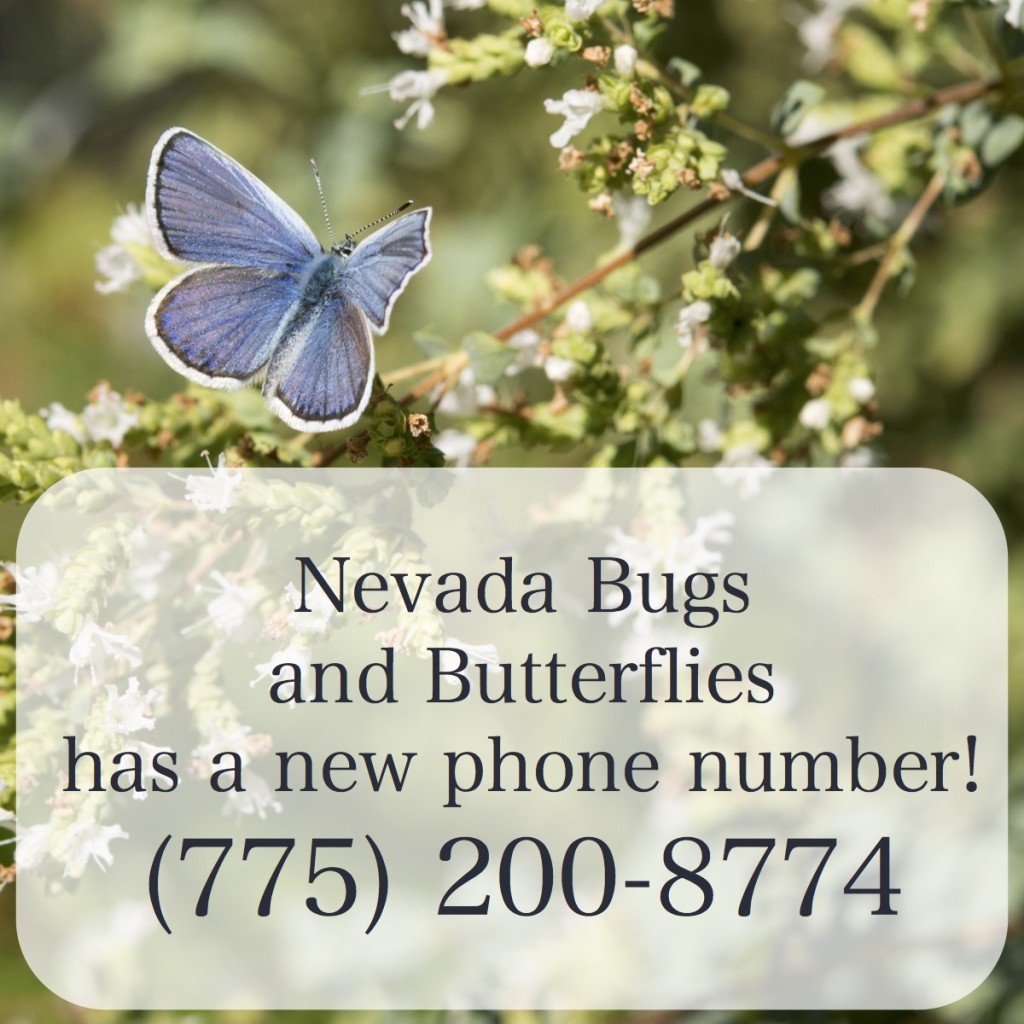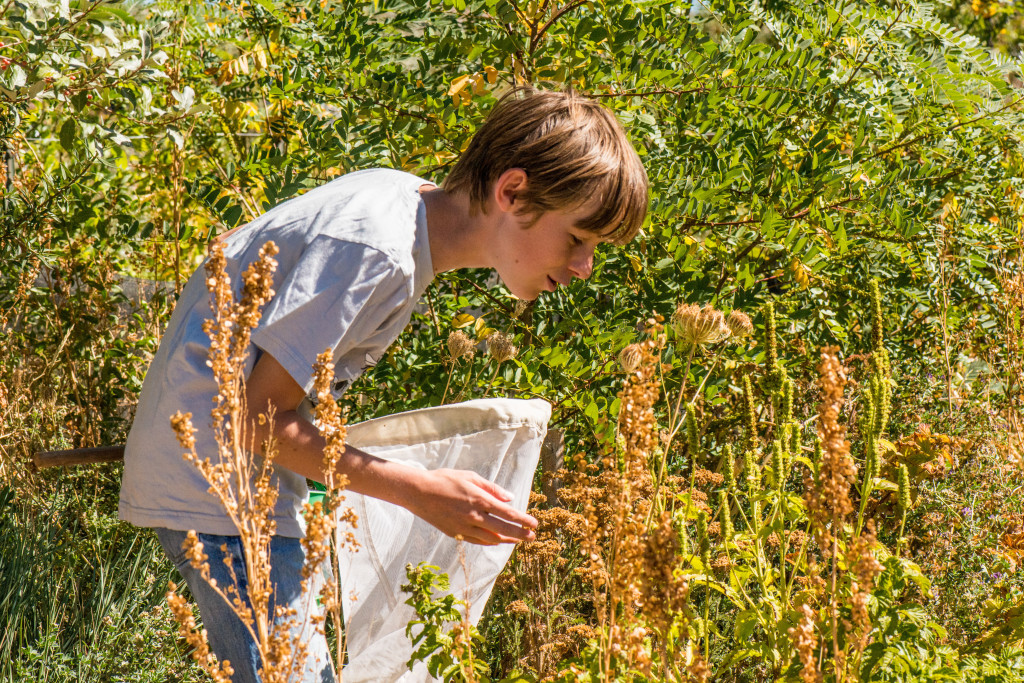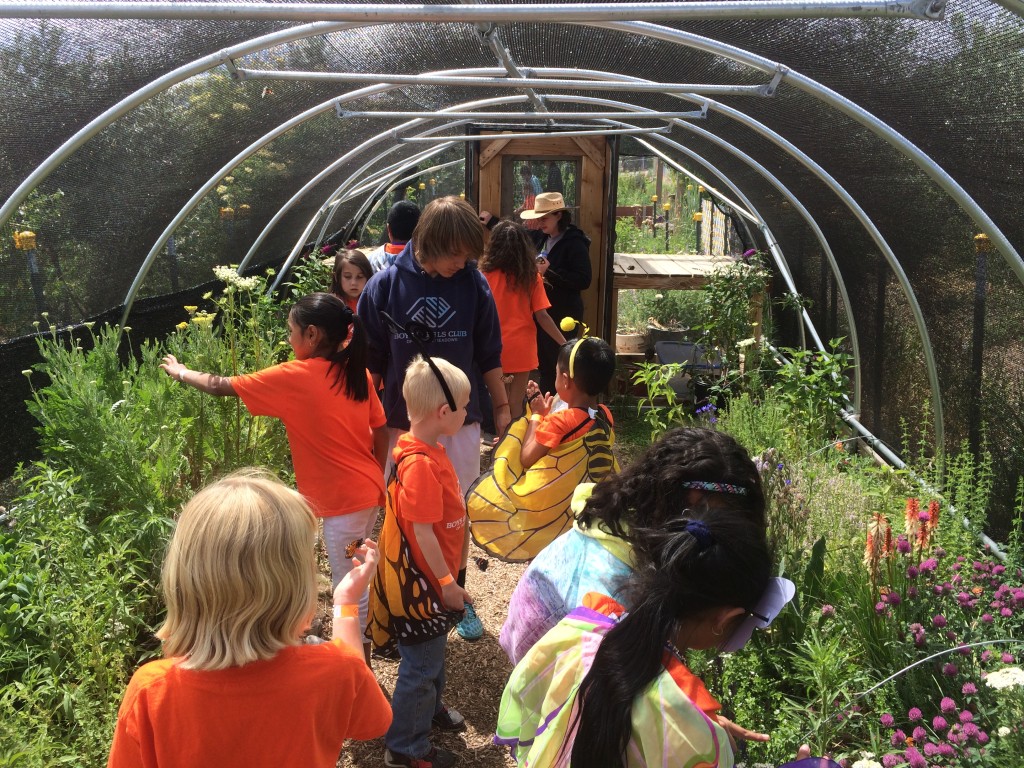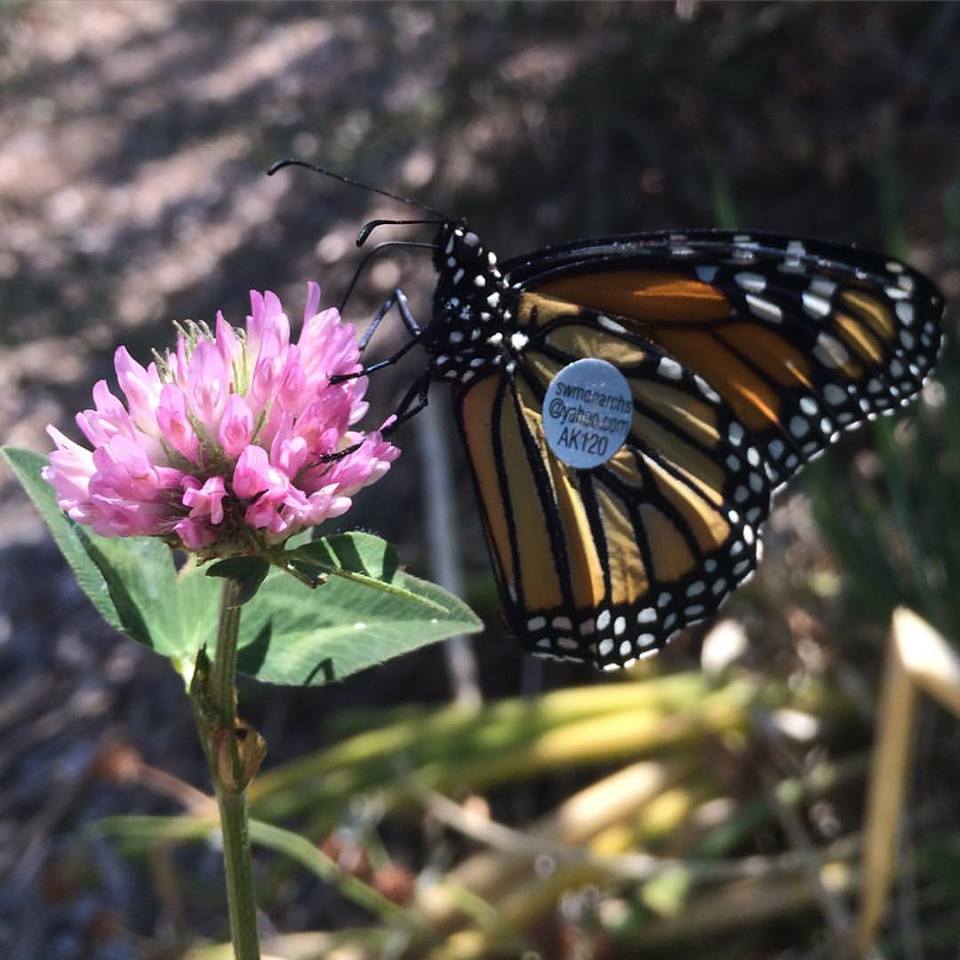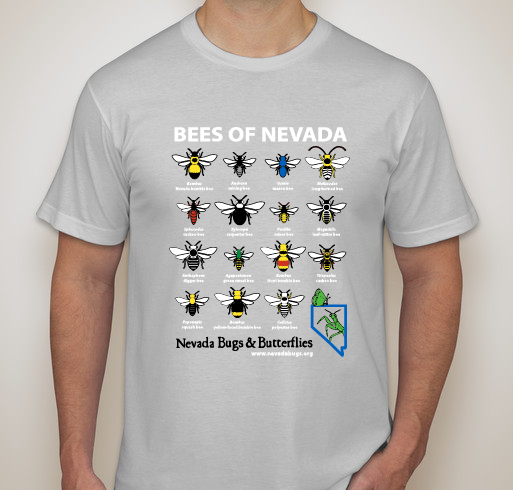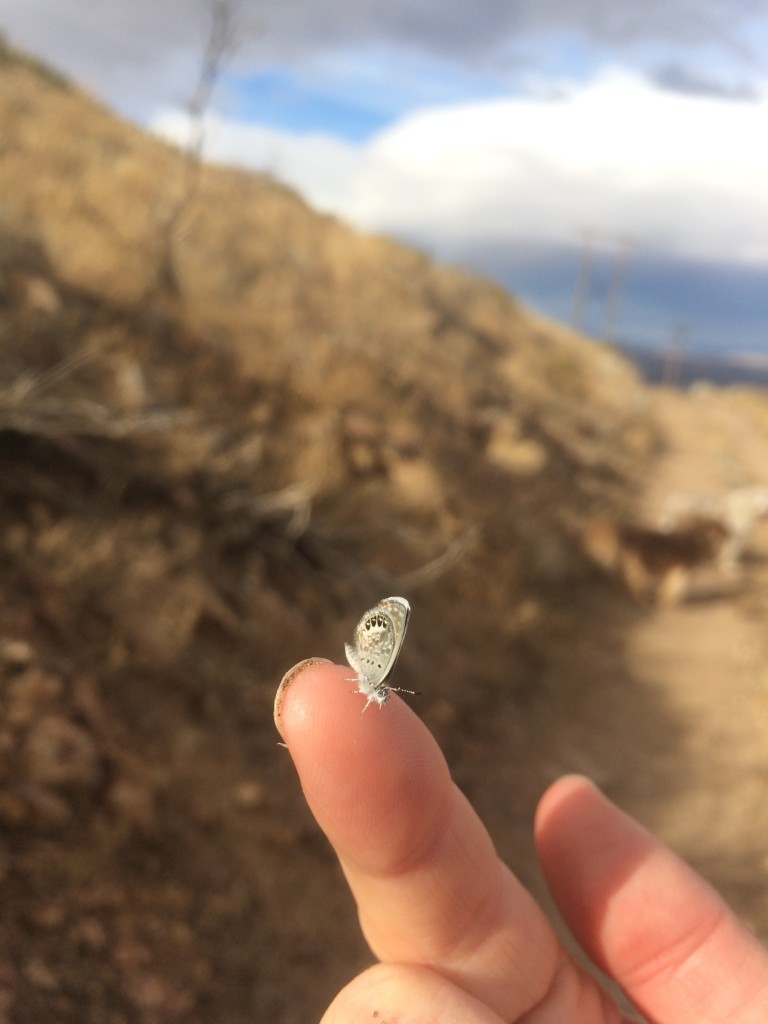Just a quick note that Nevada Bugs and Butterflies has changed its phone number! As always, you can also always email us!
Nevada Bugs and Butterflies
Bugs, butterflies, and love of the natural world..
Author Archives: NVBugs
Reflections on a successful season
With the arrival of Thanksgiving this week, and as the weather continues to change and remind us that winter really is coming, it seems like an appropriate time for Nevada Bugs and Butterflies to reflect on yet another busy and successful year. We finished our fourth season at the butterfly house with 2,284 visitors (by far our highest attendance yet), meeting hundreds of new families and students and hosting our 3rd annual monarch tag and release event. 2016 was also a wonderful year of community outreach events, including our native bee talk with Dr. Joe Wilson, a plant and animal inventory of Idlewild Park with Truckee Meadows Parks Foundation, programs at Washoe County libraries, and a local insect workshop at the Oxbow Nature Study Area. Finally, the Nevada Butterfly Monitoring Network (NBMN) had a successful inaugural season, with seven dedicated volunteers monitoring 9 routes in natural areas, contributing valuable data and laying the foundation for a long-term dataset of butterfly diversity in our region.
All these programs would not have been possible without the dedication of many people, including our board of directors, our 7 amazing science education interns Bradlyn, Dylan, Ellen, Irene, Javier, Rebekah, and Tiffany; our volunteers from the Sanford Center’s RSVP program Bradley, Deborah, and Patty; our NBMN volunteers; and countless other volunteers at the butterfly house and outreach events throughout the year who volunteered over 1,200 hours of their time and energy to make this year so successful. Thank you!
Finally, we would like to thank our donors and the continued support of foundations (read more below) whose generosity enables us to carry out our mission. Our organization has always been community-supported, and as the holiday season approaches, your end-of-year contributions are a significant part of how we prepare our goals for the coming year. You can make a tax-deductible donation to Nevada Bugs by clicking the link below, or even support us with your holiday shopping (see below). Either way, your contributions will go directly toward providing high quality science education in the Reno area in 2017.
Thank you again to all our visitors, volunteers, donors, and other supporters, and have a wonderful holiday season!
–Kevin & Cynthia
Monarch tagging and end of the 2016 season!
Cooler days and earlier nights can only mean one thing- fall is soon approaching, and with it the last two weekends of our 2016 summer season! That’s right, our last open days will be Sept. 15-17 and 22-24! If you haven’t made it out yet, these cooler days in mid-September are a great time to visit- the sunchokes are blooming with bright yellow flowers, bees are still busy collecting pollen and nectar, and skipper butterflies are flitting about the garden.
And, for the 3rd year in a row, we’ll be hosting our monarch butterfly tag-and-release event during our open days on Sept 15-17. Monarch butterflies (Danaus plexippus) in the United States are famous for their migration each winter; monarchs east of the Rockies head to Mexico, while those west of the Rockies, including in Nevada, head to the coast of California. Our event is part of a citizen science project called the Southwest Monarch Study, aimed at understanding and conserving the monarch migration of the western United States. We’ll have a short introduction to monarch biology followed by tagging an adult monarch (using a small adhesive sticker like the one above) that is then released to complete its migration. These tags can then be recorded by observers in their overwintering habitat. This year our presentations will take place on the hour from 11-2 each of our three open days.
We hope to see you out there in the next couple weeks to enjoy this beautiful late summer in Nevada!
Butterfly house closed for Saturday, July 2nd
Hi folks! Just a reminder that we are closed Saturday, July 2nd, for the 4th of July holiday weekend. We will reopen on Thursday, July 7th, and will be open regular hours (Thurs-Fri-Sat, 10-3) until September 24th. Thank you and enjoy the holiday weekend!
Opening day 2016 and 2nd annual National Pollinator Week event!
Science center opening day is this Thursday!
That says it! We are so excited to begin our fourth season (can you believe it?) at out science center and butterfly house. We’ve been raising butterflies for weeks, and we are ready to put them in our mesh-enclosed butterfly house for all to enjoy! In addition to the butterfly house, the garden is bigger and lusher than ever, our Mojave desert tortoises Tessie and Watson are with us again, we’ll have friendly millipedes, beetles, and other invertebrates to see and touch, and a host of other activities on site. As in the past, we’re open every Thursday, Friday, and Saturday from June 16 to Sept 24th (closed on Saturday, July 2). We can’t wait to see everyone throughout the summer, and as always you can find directions, recommendations, and other information about our science center on our website at https://nevadabugs.org/come-visit-us/. And, it’s the perfect time to schedule your group visit to our site! Group visits (group limit ~25 + chaperones) can be scheduled by emailing Kevin at kevin@nevadabugs.org. There are plenty of open times in July and August so just let us know!
Topping off our opening days will be the 2016 Pollinator Week event at the UNR Pollinator Garden on Wednesday, June 22nd in the courtyard of the Fleischmann Agriculture/Life Sciences building at the south end of the UNR campus. w\We’ll have garden tours, pollinator talks from local experts, native bee and butterfly specimens, a bug petting zoo, poster and plant giveaways, native bee house making, and more!
Our planned acitivity lineup includes the following sessions:
- Garden Tours (Sarah Kulpa, USFWS, in the FA courtyard): 10:00-10:30; 11:00-11:30; 1:00-1:30
- Nevada’s Native Bees (Jake Francis, UNR, in the FA courtyard): 11:45-12:00, 12:15-12:30
- Herbicide Use and Pollinators (Jay Davison, UNCE, in the FA courtyard): 11:45-12:00, 12:15-12:30
- Nevada’s Native Butterflies (Dr. Matt Forister, UNR, in the FA courtyard): 12:00-12:15, 12:30-12:45
- NDF Nursery and Native Plants (Ryan Sharrer, NDF, in the FA courtyard): 12:00-12:15, 12:30-12:45)
- Monarch Citizen Science Training (Nevada Bugs and Butterflies, in Fleischmann Agriculture room 300G): 2:00-3:00
This event is free and open to the public! Free parking spots for this event are available on the top level of the West Stadium Garage, and streetside parking is also available at the south end of campus on 9th St. and Evans Ave.
We can’t wait to welcome both our many returning families as well as many new ones we’ve met in the past year out to our science center this summer. We’ll see you out there!
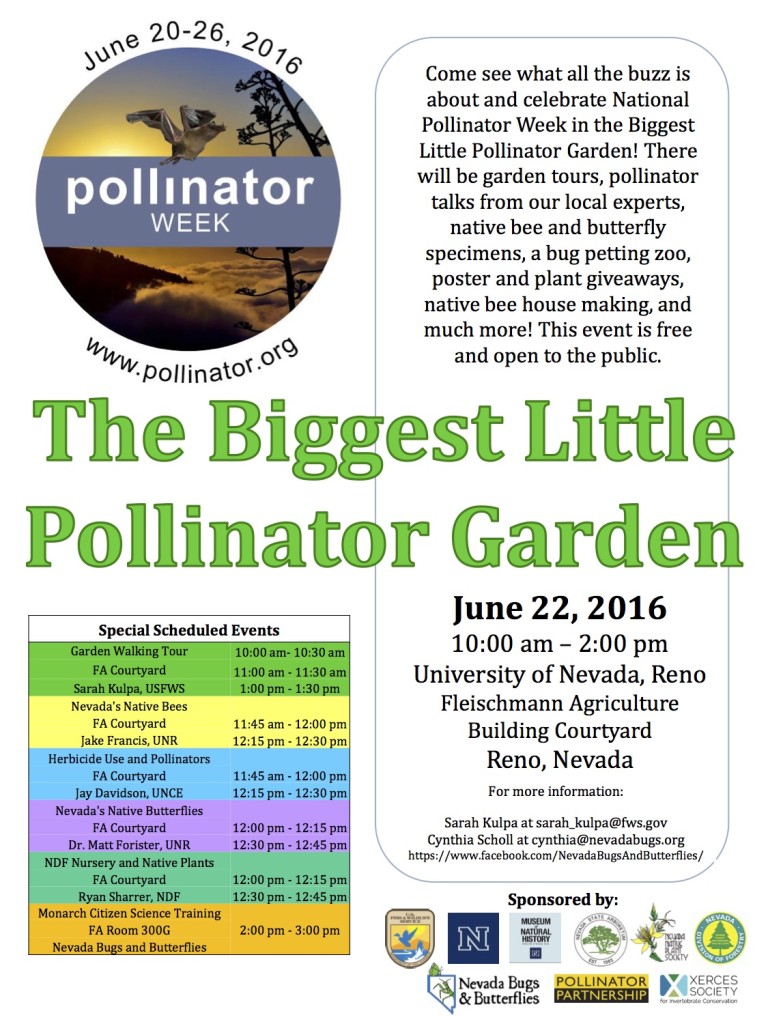
You can also RSVP on our Facebook page for this event!
Get your own special release Nevada Bee-Shirt!
Nevada is home to over 1000 species of native bees that are important pollinators of both wildflowers and many food crops. They come in all shapes and sizes, and they can be found in a wide variety of habitats. Despite being so important, bees are often misunderstood and many populations are in decline.
In order to celebrate these amazing creatures, we’ve created this special release t-shirt that highlights the incredible diversity in color, shape, and size of these amazing invertebrates. Designed by our wonderful and talented board member Angela Hornsby, these shirts are a great way to educate others about the importance and diversity of native bees and highlight your support for the tiny pollinators that work hard every day to help create a healthy ecosystem. Nevada Bugs and Butterflies is proud to support quality science education about native biodiversity in our area, and we provide pollinator education throughout the year. Proceeds from this sale will go directly towards our various educational programs, including workshops, talks, and take-home activities at our seasonal science center, like making your own native bee habitat!
Shirts are shipped directly to your address, order yours online today!
Native Bee Talk by professor and author Joseph Wilson on May 12th
We are very excited to announce the next activity in our spring lineup, a talk by professor and author Joseph Wilson titled “Get to know the bees in your backyard.”
Bees are arguably one of the most important insect groups on the planet, but despite their importance they are remarkably misunderstood. For example, it is commonly thought that the U.S. and Canada are home to just a handful of bumble bees, sweat bees, and honey bees. In fact, there are over 4,000 species of bees native to the North America! This talk aims to dispel the common myths of bees, and will provide engaging accounts of the bees encountered in this region of the world, with clues for telling these stunning creatures apart.
Dr. Wilson is an assistant professor of biology at Utah State University Tooele and author of the newly published book The bees in your backyard: A guide to North America’s bees. Copies of the book will be for sale and Dr. Wilson will be signing books following the talk.
This free talk will be held on Thursday, May 12th at 6:30 pm at the Wilbur D. May Museum (inside Rancho San Rafael Park in Reno). The talk is co-sponsored by Nevada Bugs and the UNR Museum of Natural History. It’s sure to be a great time, packed with information and beautiful pictures, and we hope many of you will join us! Send us an email if you have any questions.
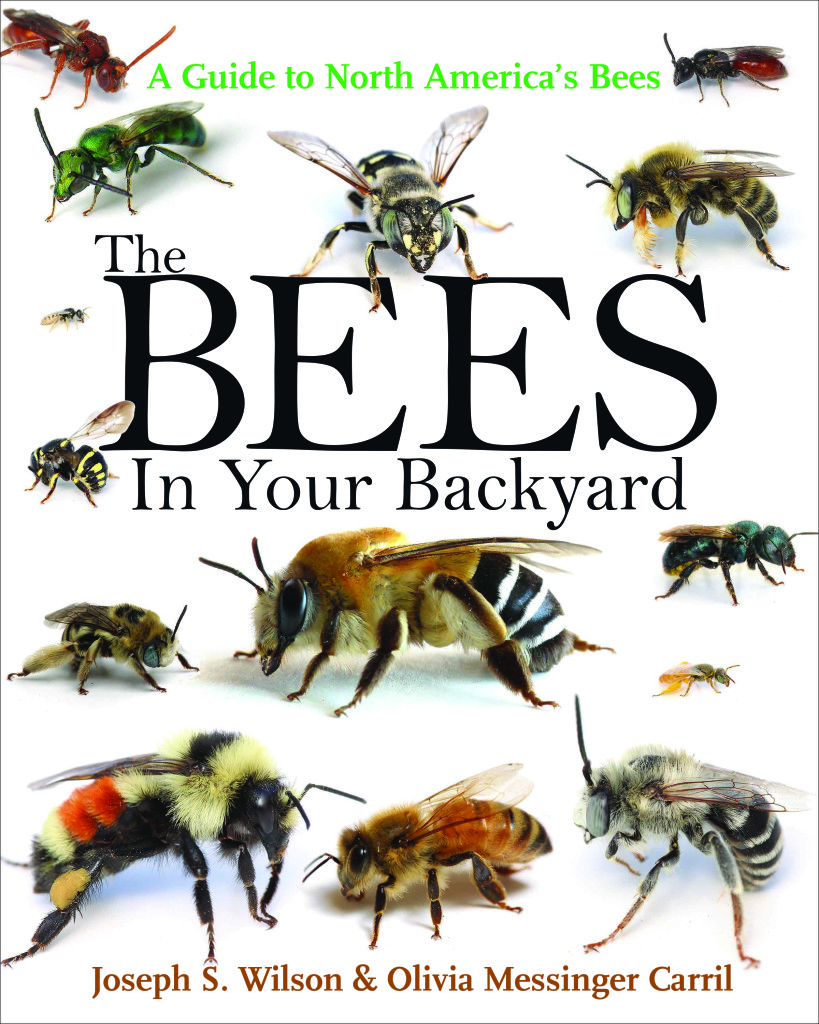
Joe’s book is also available for purchase from Amazon
Winter life for the insects
As we all enjoy some much-needed snow (and warm days in between!) this winter, one of the most common questions we get is about how insects survive the winter. And, as with other parts of insect biology, there are a wide variety of strategies. Using butterflies as examples, each species has its own strategy to survive from one fall to the next spring, or a way to ‘overwinter.’ Check out the pictures below to see how some Nevada butterflies overwinter!

One of the most famous strategies is migration to warmer locations, just like birds. The monarch migrates in the fall from northern latitudes to specific locations in central Mexico, southern Arizona, or coastal California, with the same individuals flying north again in the spring.

Painted ladies may overwinter in warmer areas as well, with populations reproducing all year long in warm climates and some individuals moving north each spring.

Buckeyes are similar to painted ladies; they may re-colonize the same area over and over as it warms up from spring into summer, sometimes returning in huge numbers.

The Melissa blue overwinters as an egg. In late summer, the adult Melissa blue will lay an egg on its hostplant (the plant required by caterpillars to survive), lupines or milk-vetches, and the egg will wait to hatch until the following spring when the plant begins to grow again. When the caterpillar emerges, it will be ready to eat!

The common ringlet overwinters as a caterpillar. Often the caterpillars will roll up inside dead leaves, or tuck in tightly at the base of their hostplant (for the common ringlet that is native grasses), and come out of hibernation when the warm weather returns.
The Stillwater Foundation awards grant to Nevada Bugs!
We are very pleased to announce that Nevada Bugs has been awarded a grant from the Stillwater Foundation, located in Reno, Nevada! The Stillwater Foundation seeks to promote global well being by supporting organizations that provide youth development and education, contribute to medical research and outreach, and promote environmental stewardship. We are proud that our outdoor science center and outreach programs serve as educational resources for the community in and around Reno. With the science center and butterfly house closed for the winter after a third hugely successful season, our organization’s work continues with outreach events at schools and youth groups throughout the year. We are also already planning for next year’s season at the science center and beyond, including educational workshops about pollinator identification and conservation and the creation of a citizen science butterfly monitoring program to be a part of the North American Butterfly Monitoring Network. Funds from organizations like the Stillwater Foundation go directly into this programming and we are so thankful for their support of our mission!
Second annual monarch tag and release event, Sept. 10-12, 17-19
The end of our butterfly house season is fast approaching (can you believe only two more weekends?), and we are closing out with a fun family event. On our last two sets of open days, Sept. 10-12 and 17-19, we’ll be having our second annual monarch tag and release event! This is part of a citizen science project called the Southwest Monarch Study, aimed at understanding and conserving the monarch migration of the western United States. We’ll have a short introduction to monarch biology followed by tagging an adult monarch that will be released to migrate south towards the coast of California. These tags can then be recorded by observers in their overwintering habitats, such as Pacific Grove and Pismo. We’ll have a presentation once an hour from 10:30-2:30 each day (weather permitting). This is a great opportunity to see the butterfly house and garden in the beauty of late summer and learn more about this beautiful and endangered native butterfly. Hope to see you there!

